Use of nanotechnology in the diagnosis and treatment of coronavirus
Abstract
Coronavirus is a beta virus that has caused a worldwide pandemic since December 2019. Many treatments such as antiviral drugs, immunosuppressive drugs, neutralizing antibodies, and monoclonal antibodies have been tested on coronavirus disease 2019 (COVID-19) that most of them were effective. Given that nanotechnology-based approaches have been successful in detection and treatment of viral systems such as human immunodeficiency virus (HIV), influenza A virus subtype H1N1 and Middle East respiratory syndrome coronavirus (MERS-CoV), they also seem to be effective in detecting and treating COVID-19. Nanotechnology is used in various methods for early and rapid diagnosis of the disease. Nanoparticles can be used in products for the diagnosis, treatment and prevention of COVID-19. These substances are very effective in the controlled delivery of antiviral drugs and biomolecules and they are also used in the manufacture of personal safety equipment, widely, and the production of anti-virus coatings for surfaces, air filters and the production of vaccines. In general, nanomaterial can play an important role in controlling the disease, based on strategies to prevent the virus from entering the host cell, inhibiting virus replication, virus delivery systems, and nano-based vaccines. Nanotechnology is a multidisciplinary tool that can offer a variety of solutions based on disease prevention, diagnosis and treatment strategies.
Keywords
References
Rehman SU, Shafique L, Ihsan A, Liu Q. Evolutionary Trajectory for the Emergence of Novel Coronavirus SARS-CoV-2. Pathogens. 2020; 9(3):240.
Ruiz-Hitzky E, Darder M, Wicklein B, Ruiz-Garcia C, Martín-Sampedro R, Del Real G, et al. Nanotechnology Responses to COVID-19. Adv Healthc Mater. 2020; 9(19):e2000979.
Ou X, Liu Y, Lei X, Li P, Mi D, Ren L, et al. Characterization of spike glycoprotein of SARS-CoV-2 on virus entry and its immune cross-reactivity with SARS-CoV. Nat Commun. 2020; 11(1):1620.
Zumla A, Chan JF, Azhar EI, Hui DS, Yuen KY. Coronaviruses - drug discovery and therapeutic options. Nat Rev Drug Discov. 2016; 15(5):327-47.
Khan M, Adil SF, Alkhathlan HZ, Tahir MN, Saif S, Khan M, et al. COVID-19: A Global Challenge with Old History, Epidemiology and Progress So Far. Molecules. 2020; 26(1):39.
Forster P, Forster L, Renfrew C, Forster M. Phylogenetic network analysis of SARS-CoV-2 genomes. Proc Natl Acad Sci USA. 2020; 117(17):9241-3.
Guan WJ, Ni ZY, Hu Y, Liang WH, Ou CQ, He JX, et al. Clinical Characteristics of Coronavirus Disease 2019 in China. N Engl J Med. 2020; 382(18):1708-20.
Tang Z, Zhang X, Shu Y, Guo M, Zhang H, Tao W. Insights from nanotechnology in COVID-19 treatment. Nano Today. 2021; 36:101019.
Walls AC, Park YJ, Tortorici MA, Wall A, McGuire AT, Veesler D. Structure, Function, and Antigenicity of the SARS-CoV-2 Spike Glycoprotein. Cell. 2020; 181(2):281-92.e6.
Tian X, Li C, Huang A, Xia S, Lu S, Shi Z, et al. Potent binding of 2019 novel coronavirus spike protein by a SARS coronavirus-specific human monoclonal antibody. Emerg Microbes Infect. 2020; 9(1):382-5.
Mizumoto K, Kagaya K, Zarebski A, Chowell G. Estimating the asymptomatic proportion of coronavirus disease 2019 (COVID-19) cases on board the Diamond Princess cruise ship, Yokohama, Japan, 2020. Euro Surveill. 2020; 25(10):2000180.
Grein J, Ohmagari N, Shin D, Diaz G, Asperges E, Castagna A, et al. Compassionate Use of Remdesivir for Patients with Severe Covid-19. N Engl J Med. 2020; 382(24):2327-36.
Bhavana V, Thakor P, Singh SB, Mehra NK. COVID-19: Pathophysiology, treatment options, nanotechnology approaches, and research agenda to combating the SARS-CoV2 pandemic. Life Sci. 2020; 261:118336.
UK researchers launch trial of blood plasma therapy for Covid-19. UK researchers launch trial of blood plasma therapy for Covid-19 2020 [updated May 4th, 2020]. Available at: https://www.clinicaltrialsarena.com/news/uk-blood-plasma-covid-19-trial/.
Jindal S, Gopinath P. Nanotechnology based approaches for combatting COVID-19 viral infection. Nano Express. 2020 1(2).
Chauhan G, Madou MJ, Kalra S, Chopra V, Ghosh D, Martinez-Chapa SO. Nanotechnology for COVID-19: Therapeutics and Vaccine Research. ACS Nano. 2020; 14(7):7760-82.
Luo F, Long C, Wu Z, Xiong H, Chen M, Zhang X, et al. Functional silica nanospheres for sensitive detection of H9N2 avian influenza virus based on immunomagnetic separation. Sens Actuators B Chem. 2020; 310:127831.
Singh R, Hong S, Jang J. Label-free detection of influenza viruses using a reduced graphene oxide-based electrochemical immunosensor integrated with a microfluidic platform. Sci Rep. 2017; 7:42771.
Lara HH, Ayala-Nuñez NV, Ixtepan-Turrent L, Rodriguez-Padilla C. Mode of antiviral action of silver nanoparticles against HIV-1. J Nanobiotechnology. 2010; 8:1.
Yang X, Li C, Huang C. Curcumin modified silver nanoparticles for highly efficient inhibition of respiratory syncytial virus infection. Nanoscale. 2016; 8(5):3040-8.
Mhlwatika Z, Aderibigbe B. Application of dendrimers for the treatment of infectious diseases. Molecules. 2018; 23(9):2205.
Pollock S, Nichita N, Böhmer A, Radulescu C, Dwek R, Zitzmann N. Polyunsaturated liposomes are antiviral against hepatitis B and C viruses and HIV by decreasing cholesterol levels in infected cells. Proc Natl Acad Sci U S A. 2010; 107(40):17176-81.
Wang N, Wei C, Zhang Z, Liu T, Wang T. Aluminum Nanoparticles Acting as a Pulmonary Vaccine Adjuvant-Delivery System (VADS) Able to Safely Elicit Robust Systemic and Mucosal Immunity. J Inorg Organomet
DOI: https://doi.org/10.52547/JCBioR.2.2.44
Refbacks
- There are currently no refbacks.
Copyright (c) 2021 © The Author(s)

This work is licensed under a Creative Commons Attribution-NonCommercial 4.0 International License.













